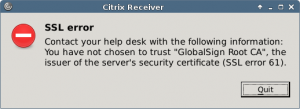In previous posts I have covered a basic installation of guacamole, using a user-mapping.xml file to define users and connections, I have also covered how to publish guacamole using apache2 over HTTPS whist protecting your deployment with fail2ban and ufw.
In this post I outline the steps required to move your guacamole installation to a mysql back-end.
First, lets install and configure mysql – you’ll need a root password and a password for the “guacamole” mysql user:
# Install mysql server apt-get install mysql-server # you'll be prompted for a root user account password <password> # review /etc/mysql/my.cnf for bindings, by default mysql will listen on 127.0.0.1 only. vi /etc/mysql/my.cnf # secure your mysql deployment mysql_secure_installation # prepare the database and user needed for guacamole mysql -u root -p CREATE DATABASE guacamole; CREATE USER 'guacamole'@'localhost' IDENTIFIED BY '<password>'; GRANT SELECT,INSERT,UPDATE,DELETE ON guacamole.* TO 'guacamole'@'localhost'; FLUSH PRIVILEGES; quit
Download and deploy the mysql extension for guacamole (this must match the version of guacamole-client you are using):
cd ~ wget http://netix.dl.sourceforge.net/project/guacamole/current/extensions/guacamole-auth-jdbc-0.9.9.tar.gz tar -zxvf guacamole-auth-jdbc-0.9.9.tar.gz cd ~/guacamole-auth-jdbc-0.9.9/mysql cp *.jar /etc/guacamole/extensions/ cd..
Now prepare the guacmole database using the supplied scripts:
cd ~/guacamole-auth-jdbc-0.9.9/mysql cat schema/*.sql | mysql -u root -p guacamole
Next, download and deploy the mysql java connection library:
cd ~ wget https://cdn.mysql.com//Downloads/Connector-J/mysql-connector-java-5.1.40.tar.gz tar -zxvf mysql-connector-java-5.1.40.tar.gz cd mysql-connector-java-5.1.40 cp mysql-connector-java-5.1.40-bin.jar /etc/guacamole/lib/
Finally, you can clear the contents of your guacamole.properties file and add only the lines below, be sure to change the mysql user password accordingly – note you will need to recreate you user mappings via the guacamole admin console.
vi /etc/guacamole/guacamole.properties # MySQL properties mysql-hostname: localhost mysql-port: 3306 mysql-database: guacamole mysql-username: guacamole mysql-password: <password>
Now restart tomcat8 (using “systemctl restart tomcat8” and browse to your guacamole deployment – you should be able to login using the credentials guacamole / guacamole.
As an aside, I did run into an issue where, having built the guacamole-client via git clone, I was unable to login using guacamole / guacamole credentials.
I was able to find an error in catalina.out:
cat /var/log/tomcat8/catalina.out | grep guacamole-auth-jdbc-mysql-0.9.9.jar
ERROR o.a.g.extension.ExtensionModule – Extension “guacamole-auth-jdbc-mysql-0.9.9.jar” could not be loaded: Authentication provider class cannot be loaded (wrong version of API?)
My solution was to stop tomcat8, remove the guacamole.war file, guacamole tomcat8 directory and then re-dploy the guacamole client, using the commands below:
# stop tomcat8 systemctl stop tomcat8 # remove guacamole files/ directoryrm /var/lib/tomcat8/webapps/guacamole.war rm -r /var/lib/tomcat8/webapps/guacamole/ # download the pre-built guacamole-client wget -O guacamole.war http://downloads.sourceforge.net/project/guacamole/current/binary/guacamole-0.9.9.war # deploy and create symlink under tomcat8 cp /guacamole/target/guacamole.war /etc/guacamole/ ln -s /etc/guacamole/guacamole.war /var/lib/tomcat8/webapps/ # start tomcat8 systemctl start tomcat8
